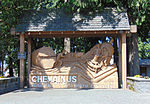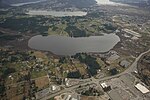CJSU-FM
1964 establishments in British ColumbiaAdult hits radio stations in CanadaBritish Columbia radio station stubsDuncan, British ColumbiaRadio stations established in 1964 ... and 2 more
Radio stations in British ColumbiaVista Radio stations
CJSU-FM is a Canadian radio station that broadcasts at 89.7 FM in Duncan, British Columbia. The station is owned by Vista Broadcast Group and broadcasts an adult hits format branded as 89.7 Sun FM. The station originally began broadcasting in 1964 as CKAY at 1500 AM, until the switch to the FM dial was made on August 1, 2000, and the station recalled.
Excerpt from the Wikipedia article CJSU-FM (License: CC BY-SA 3.0, Authors).CJSU-FM
BC Tel Road,
Geographical coordinates (GPS) Address Nearby Places Show on map
Geographical coordinates (GPS)
| Latitude | Longitude |
|---|---|
| N 48.860277777778 ° | E -123.75694444444 ° |
Address
Mount Sicker FM Radio Transmitter Site
BC Tel Road
British Columbia, Canada
Open on Google Maps




